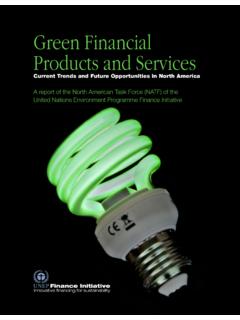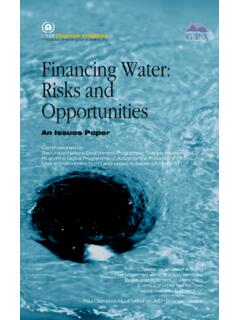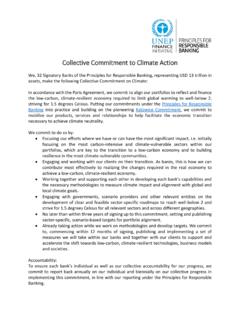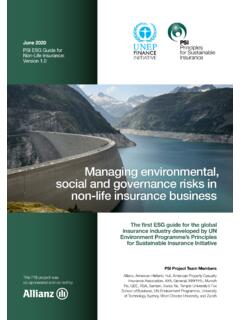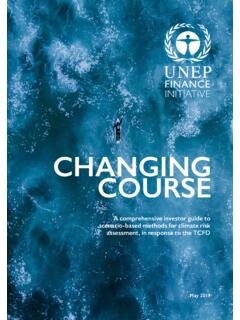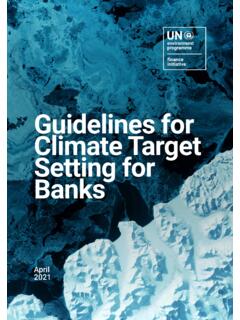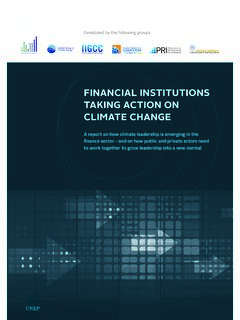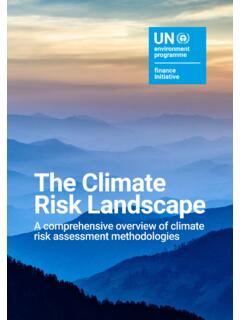Transcription of Biodiversity Target-setting
1 Principles for Responsible BankingGuidance for banksBiodiversity Target-settingVersion 1 (June 2021) Biodiversity Target-setting 2 DisclaimerThis document is based on discussions and work undertaken in the Principles for Responsible Banking (PRB) Biodiversity working group . It is designed to address the needs of Signatories who have identified Biodiversity as one of their significant impact areas within the PRB implementation process. Acknowledgment of contributions does not imply endorsement of this guidance nor of the materials referred to. Working group participation does not imply any liability or commitment to any particular policy or course of The content of this document is based on discussions and work undertaken in the Prin-ciples for Responsible Banking (PRB) Biodiversity working group : Biodiversity Target-setting 3 Project team For UNEP Finance Initiative: Jessica Smith, Alexander Sasha Wiese, Christopher Czura, Dennis Fritsch, Klaas de Vos, Tumelo Puleng Ndjwili-Potele, Johanna Dichtl.
2 For UNEP World Conservation Monitoring Centre (UNEP-WCMC): Katie Leach, Matt also wish to acknowledge contributions made by the following contributors and reviewers: Annelisa Grigg, Global Balance; Gemma James and Ana Lima, PRI; Joseph Power, Thomas Maddox, and Marcelo Lima, CDP; James Spurgeon, Sustain Value; Maxim Verge-ichik, UNDP; Onno van den Heuvel, UNEP; Danielle Carreira, World Economic Forum; Nina Seega, Cambridge Institute for Sustainability Leadership (CISL); Niki Mardas, Sarah Roger-son, James Richens, and Helen Belfield, Global Canopy; Richard Lee, Elisa Vacherand, WWF; Samantha McCraine and Siobhan Cleary, Science-based Targets Network (SBTN); Chris Weber (formerly SBTN now Blackrock); Maki Shibatsuchi, Mitusuru Miyasaka, Hiro-kazu Ikebukuro, Tezuka and Yuuki Sugiyama, MUFG Bank; Chris Smith, Bankers without Boundaries; Helen Temple and Malcolm Starkey, The Biodiversity Consultancy; Odile Conchou, Convention on Biological Diversity (CBD) Secretariat; James Dalton, citationUNEP FI and UNEP-WCMC (2021).
3 Biodiversity Target-setting : Guidance for banks (Version 1: June 2021), Principles for Responsible Banking. UNEP Finance Initiative: Geneva. United Nations Environment Programme 2021 Biodiversity Target-setting 4 SummarySummary The Principles for Responsible Banking (PRB) were developed by the banking industry in collaboration with the United Nations Environment Programme Finance Initiative (UNEP FI). In an era of increased expectations and scrutiny for banks to contribute to achiev-ing the Sustainable Development Goals, Paris Agreement, and other norms and stan-dards set by their customers, investors and society-at-large, the Principles define what it means to be a responsible bank. There are more than 230 signatories with combined assets of USD $60 trillion from around the world as at guidance primer is a resource for implementation to support PRB Signatories in preparing to set portfolio-level Biodiversity targets.
4 Version 1 is published (during June 2021), in anticipation of the finalisation of the Convention on Biological Diversity (CBD) s post-2020 Global Biodiversity Framework later this year in Kunming, and in response to other related developments such as the convergence of nature positive within defi-nitions of net zero ambition in the remaining months until the Glasgow UNFCCC COP. It is expected that in the next 6 12 months there will be agreed global Biodiversity goals that give clear targets and allow more harmonised metrics for nature positive portfolios. In concert, in the climate space, a more detailed roadmap for deforestation and nature-based solutions is expected that will allow for banks to converge on this topic also within their net zero strategies. Building on the Beyond Business as Usual report released in 2020, this guidance primer takes a practical approach to Biodiversity Target-setting and is based on the needs iden-tified by PRB Working group members, acknowledging Biodiversity as a key impact area and providing examples, tips and approaches to areas that are absent from existing guidance materials.
5 The specific novel elements are: a potential categorisation for use in a banking context, primed to align to science-based approaches; bank-specific case studies; bank-specific FAQs; sample positive Key Performance Indicators (KPIs); and potential Target-setting 5 SummaryThis guidance primer will allow PRB Signatories to prepare to take a systematic approach to setting and achieving Biodiversity targets in the context of the Principles, and move towards implementing their public commitment to managing their Biodiversity impacts (as well as exposure to Biodiversity -related risk, beyond the scope of PRBs). There are many complementary initiatives that will support banks over the coming months and years as well, including the Partnership for Biodiversity Accounting (PBAF), the Align project and the Taskforce on Nature-related Financial Disclosures (TNFD). UNEP FI encourages continued collaboration by banking leaders to further develop Version 1 into a comprehensive set of guidance.
6 Likely next steps include developing further case studies, defining the cash flows and KPIs in more detail (including real numbers and thresholds), showing the effect on bank returns, quantifying monetary values, and answering questions of whether there is a trade-off if a bank applies biodi-versity criteria. UNEP FI will update this guidanceiversity goals are finalised, and as good practice in this space evolves and can be Technical Annex is presented separately to allow for more rapid and frequent updat-ing. All feedback on this primer guidance and its annex should be shared with Biodiversity Target-setting 6 Table of contentsTable of contentsA. Introduction to the Biodiversity Challenge and Opportunity for Responsible Banks7 Role of the Principles for Responsible BankingBusiness case for Biodiversity targets by responsible banks1010B. Step-by-step: Portfolio-wide Biodiversity targets for banking151: Analyse exposure to priority sub-industries2: Materiality assessment of Biodiversity -related risk3: Review global Biodiversity goals and targets4a: Biodiversity Target SettingExample Targets and Corresponding KPIsEcosystem: Marine (sustainable blue economy)Ecosystem: Terrestrial (deforestation/species)Ecosystem: Freshwater4b: Business Target Setting5: Adapt Activities and Implement Changes6: Reporting1717181920212223242425C.
7 Case Studies using the Step-by-Step approach261: ING on Agriculture2: Credit Suisse on Blue Economy3: Rabobank on Deforestation-free portfolios 4: Mitsubishi UFJ Financial group (MUFG)27303235D. Frequently Asked Questions38E. Next steps and further collaboration40 Biodiversity Target-setting 7 Introduction to the Biodiversity Challenge and Opportunity for Responsible BanksA. Introduction to the Biodiversity Challenge and Opportunity for Responsible Banks Biodiversity underpins all economic activities through the provision of a range of ecosys-tem services, and it is experiencing dangerous and unprecedented declines due to the current model of economic development. The world s ecosystems have declined in size and condition by 47% globally compared to estimated baselines, and the continued degradation of ecosystem services represents an annual loss of at least US$479 billion per year.
8 With recent estimates stating that more than half of the world s total Gross Domestic Product is moderately or highly dependent on ecosystem services, these declines in Biodiversity are a signal that action needs to be taken to strengthen the global economy s resilience. Banks are exposed to multiple types of Biodiversity -related risk through their various activities, including risk of default by clients. Working with their client and/or customer base, banks can turn these risks into opportunities by mitigating impacts on and manag-ing investments in Biodiversity in a sustainable way, and transitioning to nature positive 1 portfolios. But what is Biodiversity and how can the loss of Biodiversity affect a bank s business activities? How can Biodiversity be broken down, so that relevance to a bank can be easily identified? A number of terms are associated with the concept of Biodiversity including: natural capital, nature, nature positive, ecosystems, and ecosystem services.
9 The difference between each concept, however, is not always clear to the banking community. This guidance includes a detailed definitions section in the Technical Annex and aims to make these concepts more understandable and tangible with regards to banking activities, in the context of delivering on PRB commitments. 1 See section D. Frequently Asked Questions and Weber, C., Stevenson, M. and McCraine, S (2021). Nature-posi-tive an opportunity to get it right Science Based Targets Target-setting 8 Introduction to the Biodiversity Challenge and Opportunity for Responsible BanksWhat is Biodiversity ? Biodiversity is defined in the Convention on Biological Diversity (CBD) as the variety of living organisms from all sources including, terrestrial, marine and aquatic ecosystems and the ecosystems they are part of. This includes diversity within species, between species and of ecosystems.
10 Biodiversity loss is inherently linked to climate change and achieving global goals for addressing one cannot go without achieving those for the Healthy, biodiverse, and therefore resilient ecosystems play a key role in preventing disruption to society and the markets within which businesses operate. For example, tidal ecosystems like mangroves play a crucial role in mitigating the impacts on human society of extreme weather events such as floods and storms. Restoring and conserving Biodiversity is critical for achieving climate mitigation and adaptation, economic welfare and societal well-being. Conversely, climate change impacts on Biodiversity will affect its ability to provide crucial ecosystem services upon which many people and businesses depend, such as water and food. In addition, climate change will affect ecosystem stability and resilience, and this is already being seen in agricultural systems that are becoming less resilient to threats such as pests and As a result, Biodiversity loss has become a systemic risk of yet unknown magnitude and there is at present too little action aiming to tackle both the interlinked Biodiversity and climate way of categorizing nature to approach portfolio Target-setting is laid out in the Science Based Targets for Nature Initial Guidance for Business.
